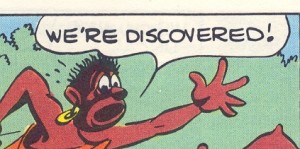Not only am I a fan of the Golden Age of Comic Books, but in a way, I am a historian as well. As a historian exploring the Golden Age I am sometimes frustrated by reprints that have altered the original source material for the sake of being politically correct.
Before I delve further into this topic let me say loud and clear that I am against any form of racial intolerance. Having said that, however, I also believe that in order to fully explore our past, we should understand the prevailing social attitudes of the bygone era, no matter how repugnant they may be to us today. It’s very difficult to understand the past when it is hidden away out of a fear of criticism or reprisal. Of course, any such exploration should be undertaken with respect and deference.
Admittedly, the contents of comic books are the property of their copyright holder, and they can do with them as they please, regardless of the hue and cry of the “historian” to be able to access the information for the purpose of learning, and in many cases, preserving. In fact, in some cases, the copyright owner should probably be applauded for obscuring some original content because of the extreme negative emotions the material may evoke.
With respect to Golden Age comic books, the Walt Disney Company is probably the champion of altering original material in order to obscure depictions that to most would be racially inappropriate (Indeed, the refusal of the company to re-release the film Song of the South is an example of this corporate policy). Even the work by the great Carl Barks was not immune from the scrutiny of the Disney censors, and in many instances his depictions were considered inappropriate. This resulted not in a refusal by the company to reprint this material, but instead in a redrawing of many of the scenes deemed unacceptable. Not only were scenes redrawn, but in some instances dialogue was also changed. This is where the frustration of the “historian” is at its peak, not being sure what is an accurate reprint of the original, or something that was altered long after the comic book was first published. The originals can always be tracked down for this historical exercise, but usually at a great cost.
I can think of one Golden Age Donald Duck adventure that truly exemplifies this effort by the Walt Disney Company, “Voodoo Hoodoo” that was originally published in Four Color Comics #238 (1949). This story involves a trip to Africa by Donald and his nephews to track down a “shrinking” curse originally aimed at Uncle Scrooge, but that has unwittingly befallen Donald. The curse was delivered to Donald in the form of a prick of his finger by a cursed voodoo doll. The doll was delivered to Donald by a very old zombie, who had wandered the earth for many years searching for Uncle Scrooge. The zombie mistakenly delivers the doll to Donald, thinking he is the young Uncle Scrooge. Donald and his nephews decide to travel to Africa to find the witch doctor who created the curse, hoping to convince him to release Donald.
From the start, the depiction of “Bombie the Zomibe” as crafted by Barks was deemed inappropriate, and the face of the character was reworked.
In addition to the reworking of the Zombie’s face, Disney deemed it necessary to redraw all of the characters encountered by Donald and his nephews in the jungles of Africa. These depictions by Barks were very stereotypical and common in the 1930’s and 1940’s, and are considered very inappropriate today. They were completely re-worked by the Disney artists before the story was ever again reprinted.
Not only were the faces of many of the characters redrawn, sometimes the dialogue was changed so that there was no inference of racial stereotyping. Here, the character’s grammar was corrected (See also, the second panel, above).
Even the features of the evil witch doctor, “Foola Zoola” were changed by the Disney company to be in line with the changes to the other characters in the story. As far as I know, the original story as written and drawn by Barks has never been reprinted without the changes seen here.
“Voodoo Hoodoo” is not the only example of Disney’s efforts to tone down the original content of a Golden Age comic book that they later deemed inappropriate for publication. As noted above, without a copy of an original edition of any of the censored comics, anyone researching these stories would be unable to completely explore the work as initially created by Barks or others. While I fully appreciate Disney’s corporate policy that prevents the original content from being reprinted, it’s unfortunate that the content as first presented is only available in expensive original editions, which precludes most interested Golden Age fans from reading the comics as initially crafted.











Pingback: Golden Age Reprints - Dell Tarzan – Golden Age of Comic Books
Pingback: A Golden Age Fairy Tale – Golden Age of Comic Books